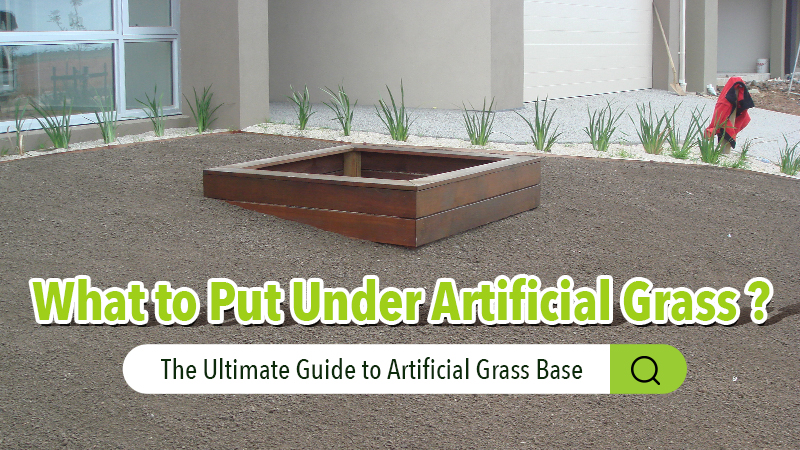What to Put Under Artificial Grass | The Ultimate Guide to Artificial Grass Base
- 11/08/2025
When planning to install artificial grass, most people focus on the turf itself — its color, pile height, or softness. While the turf gives your lawn its look and feel, a properly prepared artificial grass base is essential for long-lasting performance.
A solid, well-constructed base provides the foundation for a smooth and stable lawn. It ensures effective drainage, prevents weed growth, avoids sinking, shifting or uneven spots, and helps your turf maintain a flawless appearance year after year.
So, what do you put under artificial grass? Let’s break it down layer by layer.
In this article:
Overview: The 4 key layers uFnder artificial grass
Before diving into materials and methods, here’s a quick look at the structure beneath a typical artificial lawn:
| Layer | Main Purpose | Common Materials |
| 1. Weed Barrier | Weed prevention | Geotextile fabric, mesh weed membrane |
| 2. Sub-base | Stability & Drainage | Crushed stone, decomposed granite, gravel (as a drainage layer) |
| 3. Levelling Layer | Smooth surface | Sharp sand, granite dust |
| 4. Cushion/Optional Layer | Safety & comfort | Foam pad, drainage tiles |
Each layer has a specific role in creating a long-lasting installation. The following sections explain how to choose and install each one properly.
Weed membrane: Stop unwanted growth
A weed membrane is recommended when installing artificial grass over natural soil, especially in areas prone to weed growth. It blocks unwanted vegetation and keeps the sub-base separate from the soil, maintaining stability and proper drainage.
Types of weed membrane
- Woven geotextile fabric: Durable and ideal for high-use or heavy-traffic areas.
- Non-woven fabric: Lightweight, cost-effective, and easy to handle for residential installations.
Installation tips
- Lay the fabric evenly over the excavated area and compact the soil beneath to create a firm, level surface.
- Overlap each section by 2–3 inches to ensure full coverage and prevent weeds from finding gaps.
- Fix the fabric securely using landscape pins or galvanized nails, keeping it flat and tight across the area.
Note: For pet-friendly artificial lawns, some installers prefer to skip the membrane to improve drainage and odor control. In such cases, a well-compacted sub-base combined with an eco-friendly pre-mixed weed preventer can offer effective long-term protection against weed growth.
Artificial grass base: Build a strong and smooth foundation
The sub-base and leveling layer provide the main support for your turf, ensuring proper drainage and a smooth, even surface. Choosing the right materials is essential—so, what is the best base for artificial turf?
Sub-base: Stability & drainage
The sub-base is the primary load-bearing layer of your artificial grass installation. Its critical role is to create a stable foundation that resists shifting or settling, while ensuring efficient water drainage away from the surface.
Recommended materials for the sub-base
- Crushedstone (¾-inch minus/ Type 2) – The premium choice
A graded mix of angular, mechanically fractured stones (up to ¾ inch) blended with fine dust. This is the industry standard and the most reliable material for a high-performance sub-base.
Key advantages:
- Superior stability: The jagged particles interlock tightly when compacted, forming a rigid, interlocking structure that resists movement and settling even under heavy loads.
- Excellent drainage: The gaps between the locked stones allow water to flow freely, preventing pooling.
- Ideal for: Most installations, especially high-traffic areas, regions with frequent rainfall, and projects requiring long-term durability.
- Decomposed granite (DG)
DG is a sandy, granular material produced by the natural weathering of granite. It can perform well in the right conditions but requires careful consideration of the site environment.
Key advantage: Forms a hard, slab-like base when compacted dry, providing a smooth, even support for turf.
Important considerations: Because of its higher fines content, DG drains more slowly than crushed stone and can soften slightly when saturated. It’s best suited for well-drained soils and arid climates.
- Gravel (pea gravel)– Limited & specialized use
Gravel consists of smooth, rounded stones formed by natural erosion. It’s generally unsuitable as a primary sub-base due to its lack of structural cohesion.
Key limitation: Poor stability — the round particles don’t interlock well, leading to shifting and uneven surfaces over time.
Appropriate application: Best used as a secondary drainage layer beneath a crushed stone base in areas with extremely poor soil drainage.
Installation tips
- Compact the sub-base in 2-inch layers (lifts) for maximum density.
- Keep the material slightly damp during compaction to help bind particles.
- Ensure the final surface has a gentle slope (1–2%) away from buildings for proper runoff.
Leveling layer: The perfect finish
Once the sub-base is fully compacted, the leveling layer is applied. This final course creates a perfectly smooth surface, allowing the turf to lie flat, feel comfortable underfoot, and facilitate surface drainage.
Recommended materials for the leveling layer
- Sharp sand or concrete sand
A coarse, washed sand with angular grains — one of the most popular materials for creating a smooth and stable finish.
Key advantages:
- Workability: Easy to spread and screed for precise leveling.
- Drainage: The angular structure remains porous, allowing water to pass through efficiently.
- Granite dust (stone dust)
A byproduct of stone crushing, consisting of fine particles and dust. It produces an exceptionally smooth and firm surface.
Key advantage: Excellent for filling minor imperfections and ensuring a dense, ultra-smooth surface.
Important consideration: Less permeable than sand, so it should only be used in thin layers (up to 1 inch) over a well-draining sub-base.
Tips for a perfect finish
- Avoid using fine sand, soil, or dirt — they trap moisture and can lead to uneven sinking.
- Use a screed board over guide rails to achieve a flat, even finish.
- Do not over-compact; a light tamping is sufficient to settle the material.
Optional cushion & drainage layers
Cushion and drainage layers are not required for every installation, but they can be useful depending on the project type.
Shock pad / foam underlay
- Adds extra softness and impact absorption, ideal for playgrounds, gyms, or pet zones.
- Reduces stress on joints and provides a natural feel underfoot.
- Useful when installing over hard surfaces like concrete to smooth minor imperfections.
Drainage tiles
- Designed for installations on rooftops, balconies, or concrete surfaces.
- Improve water runoff and allow airflow beneath the turf.
- Easy to install — simply snap together the modular panels.
If the existing surface already drains well, a drainage layer is not necessary.
Conclusion
The secret to a beautiful and long-lasting artificial lawn lies in what’s underneath it.
By understanding what to put under artificial grass — including the weed barrier, sub-base, leveling layer, and optional cushion or drainage layers — you’ll create a strong foundation for lasting performance.
Whether it’s a home garden, playground, or pet area, taking the time to build a reliable base will ensure your artificial grass stays smooth, stable, and easy to maintain for years to come.




